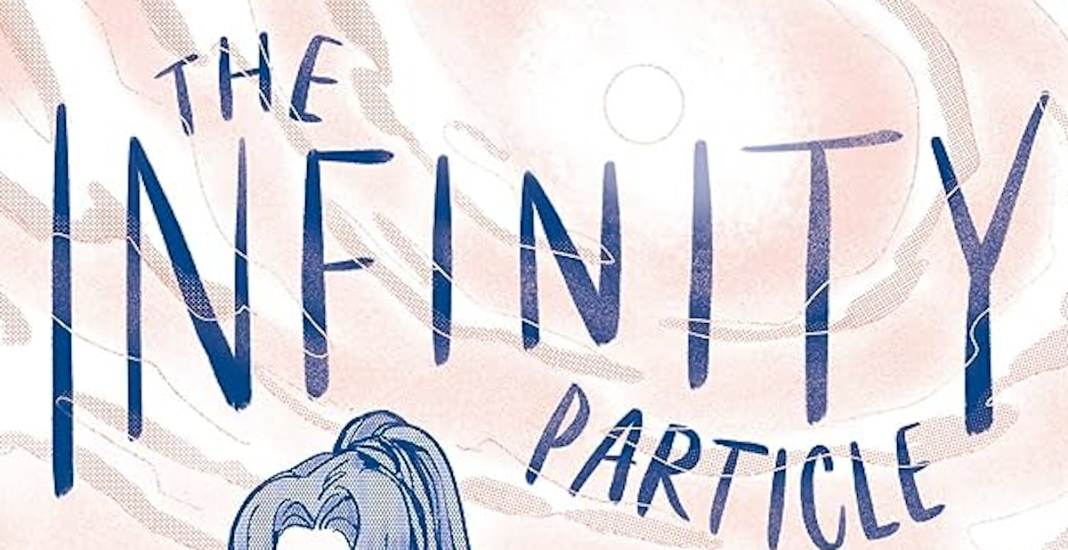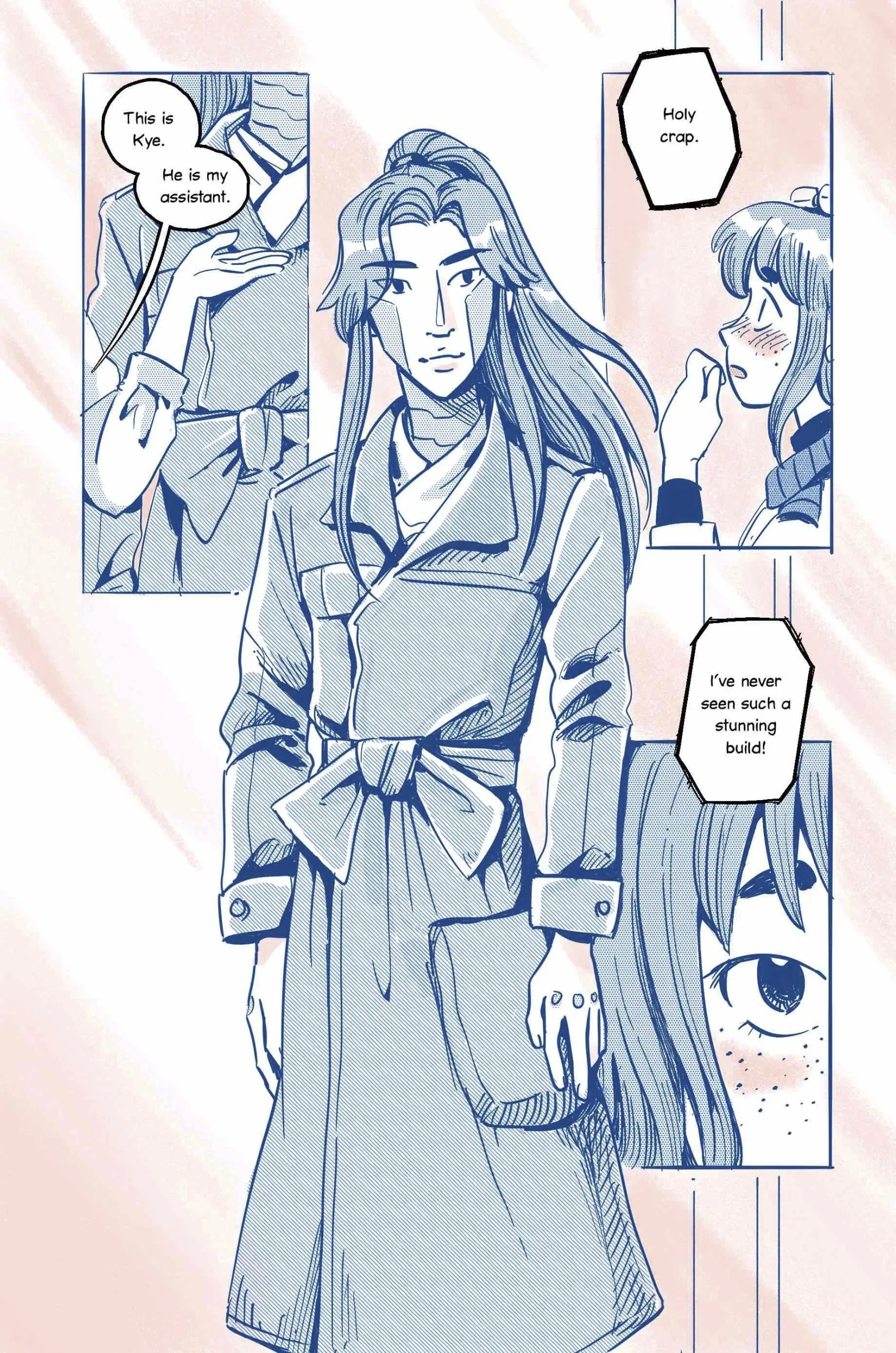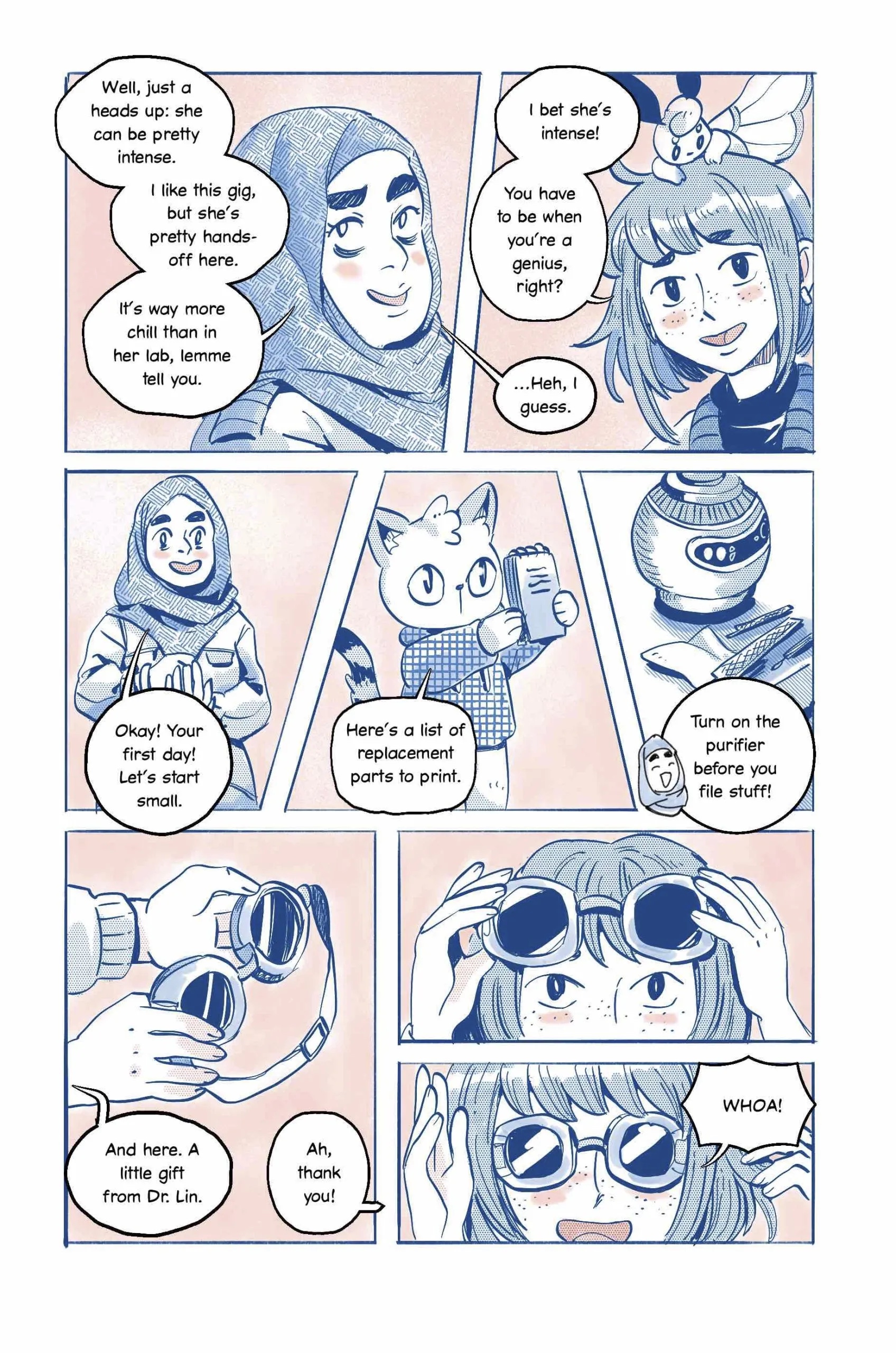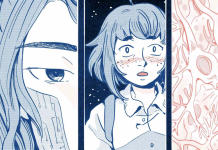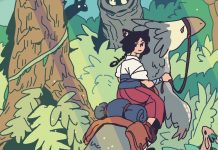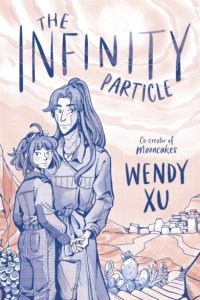
The Infinity Particle is available at your local bookstore and/or public library now. To celebrate, The Beat caught up with Xu over Zoom. We asked all about what motivated her to tell a story about Artificial Intelligence, what inspired the book’s unique color palette, and about the role fungi plays with respect to The Infinity Particle.
This interview has been edited for clarity and length.
AVERY KAPLAN: What was the genesis of The Infinity Particle? How did the book come together? Was there any character element that preceded the rest?
WENDY XU: It started with a trip to the Natural History Museum. I was looking for sea creatures. I was working on Tidesong. The Infinity Particle was pitched in 2018, but I already had Tidesong on contract. I had to do that book before I could jump into it. So this book had a really long time to cook.
But I was at the Natural History Museum. There was a special shark exhibit, I went to go get references for Tidesong. I was reading a display card that talked about a submarine that had mechanical arms attached. The sensitivity of these arms would allow it to collect soil samples with the gentleness of human hands. And I was really touched by that because it says something about how we wanted to engineer a machine that would do something with the same kind of sensitivity that we had. Because if you try to take the sample with without such sensitivity, you’ll ruin the sample. So initially, it was, “What if there was a robot who was designed for this kind of research? A humanoid robot.”
And so The Infinity Particle was initially set in an underwater lab on Earth in the future. And I thought about this underwater city. I thought about the ocean. I love the ocean.
But then, as the story progressed, there was going to be travel between Earth and another planet because of Clementine, the main character. And so they were going to travel between planets. At some point, there was a scene that took place on a spaceship when they were interstellar traveling, and then I said, “No, I don’t think I want to do interstellar travel. I’m just going to set it on a different planet.” So I decided to set it on Mars.
I thought about setting it on a water planet, I thought about keeping with the theme of a robot designed to do research. Then I started thinking about what would the architecture of Mars look like. I was walking through Midtown, and there’s all these skyscrapers, and it was really windy. And I wondered, “Can we build skyscrapers into a canyon?” But the more I looked at Mars, the more I thought like how interesting it would be to set it on Mars. It had nothing to do with Elon Musk.
Because this started in 2018, the inception for it, I had no idea how tech worked or how robotics worked. I did a lot of research. But in the process of my research, because I wanted this book to exist in conversation with current tech conversations, I became less and less and less of a tech optimist. Especially as the years went by, from 2018 to now, I became so disillusioned with Silicon Valley. So this book ended up being a little bit of my ideas about defiance of Silicon Valley ethos. A lot of the podcasts I listen to are tech critical podcasts; Tech Won’t Save Us and the Behind the Bastards episodes on Mark Zuckerberg and Bill Gates really helped shape part of the central philosophy of this book.
Right when the pandemic hit, I was reading a lot of books about nature. I had not read a lot of science writing up until this point, actually. So I read a lot of science writing, and I was so kind of inspired by the ways in which certain scientists see the natural world, I thought that was so beautiful. So I wanted to also bring a little bit of that into The Infinity Particle.
And at its heart, it’s a love story. I’m a big romantic. I think the heart of the love story is thinking about, how do we heal? Because the abusive mom was always going to be a part of it.
But, it was kind of like a murder mystery before. I had started with the idea that the mom would have killed her first child. But then I thought, “That’s a little too much. I don’t think we have to the metaphor that far.” So instead, I said, “What if she has so much trauma that she’s that she’s put all her expectations onto this thing that she’s created, this person essentially,” and I kind of built it from there. And Clem, I realized also had to have similar trauma to be able to recognize this in Kye.
So all of these things came together to create this story.
KAPLAN: When did you realize you wanted to write a story about AI?
XU: I’ve always wanted to write a story about AI. I was really fascinated since I was a kid. Since I was 13 and I read Chobits for the first time, a great Clamp classic. I read a short story in a series called The Tarot Café about an alchemist who makes a doll and he falls in love with it, even though the doll is meant for another person, for a princess. It was like kind of a fairy tale AI story. I’ve always been interested in the metaphor of, “What does an AI tell us about our humanity?”
And I’m talking about real AI. Not what the marketing people these days are calling AI, the large language models. For the record, that is not AI. Real AI doesn’t exist. Because it doesn’t exist, that gives us fiction writers so many fun things to be able to explore with it.
And it’s also about the mystery of what makes us intelligent because we really don’t know how intelligence works. We don’t know how the brain works. I studied a little bit of neuroscience in school; I was a psychology major. Brains are so weird, there’s so much we just don’t know. So I was always fascinated, psychologically: “What would an AI be like, if such a thing existed?” So those are all things that I think about a lot.
KAPLAN: What was the character design process like for you? Did any characters pose a particular challenge?
XU: The character design process was really fun. The main challenge was getting Kye to be as beautiful as possible. His hair just progressively got longer and longer. I think because I started watching a lot more Asian dramas. Finally, I said, “He has to have hair that would be a $20,000 wig on one of the shows, that’s just optimally gorgeous.” So I think that was the main challenge for Kye, making him as Bishōnen as possible. Because I always try to put what I love into every story. This was kind of like my love letter to the shōjo manga genre as well, that I grew up reading. So I just want to make beautiful, tall, handsome love interests.
And for fashion, I did a lot of thinking about what kind of fashion this would be like. But I thought, ultimately, maybe it shouldn’t be so different. Maybe it shouldn’t be so removed from our modern day that it becomes almost unrelatable. Because I while I love some of the design aesthetics in manga like Robo Sapiens, I thought that Chobits was really great because even though it was set in the future, they were all wearing contemporary clothes.
Same with Pluto, which is another one of my fictional inspirations. Because it’s a noir, the main character is a detective, he’s wearing a suit. So I thought, instead of making everyone wear futuristic cyberpunk clothes, I thought, “What would be comfortable?” Because, this is a comfortable world, right? So I just kept thinking about what would be comfortable for the characters to wear. Personally, I like big pants. I know they’re comfortable. So our main character wears a lot of big pants.
But, the main fashion inspiration for Kye, specifically that trench coat he wears at the beginning. It’s directly inspired by Rutger Hauer’s costume in Blade Runner.
KAPLAN: At what point did you choose the color palette, and was that a straightforward decision?
XU: It was not. Initially, we were going to go full color. Well, we weren’t going to do full color, we were going to do more of a limited color. I really always wanted to do a limited palette. But I thought, since Tidesong was in full color, maybe I could do this in full color, but with like less colors, period. But then I tried it. And I wanted to yeet myself off the Brooklyn Bridge. I could focus on either the lines or the colors. And I chose to focus on the lines.
Because we’re doing limited color, I had to pick two palettes that mixed well together. I ended up color-picking from a photo that the Mars Rover had taken with a lot of reds and teals and blue and gray and green Another Easter egg: the color palette is from color-picking the Mars Rover’s photo. But ultimately, you have to tweak the saturation, the desaturation, you have to tweak the values. So I don’t think a lot of people will notice and that’s fine.
But what I ended up with is this deep blue paired with reds and pinks. And I really like it, but it took like 20 tests to get there. I would literally just sit there and color one page over and over and over again until I got the right combination.
Initially from the color picker, it was a little bit more green. I do love a red-and-green but I felt like that would maybe be a little bit too not “Red Planet-y” because green is leaves and earth. But I still wanted to maintain a little bit of a cool tone. So I went with blue instead.
KAPLAN: There’s loads of sci-fi world-building, not just in terms of AI but also just in terms of Martian life and culture. I’m curious if you had a favorite detail you were able to include?
XU: Food stalls. Street food. I had a whole piece of concept art that was just street food stalls on Mars.
I feel like living in New York we’re really, really missing some good street food. So I took inspiration for that from visiting Asia, visiting Japan and China. I took a lot of inspiration for Martian life from just what I think is comfortable. What I think is comfortable are sidewalk food stalls, and tatami mats in in your living room. So I tried to incorporate a lot of that.
I had read something about growing hydroponic lettuce; I have an aquarium at home. So I chose to use that when she goes to the store. I had read about a sustainable grocery store where you bring in a jar and they’ll fill it for you with cereal, instead of boxes. So I thought that would be kind of fun to just like play around with.
My thought process for what this society was not necessarily “what is utopia,” I think because “utopia” is such a loaded word. I wanted this world to feel like it wasn’t without its problems. But I definitely wanted it to feel like it was not capitalism as we know it. Mostly as a response to Silicon Valley’s hypercapitalism, I really just wanted something to say, “This is not Silicon Valley. This is not inspired by Silicon Valley culture in any way.”
Because if you notice, the characters are going out to lots of public institutions, they’re going to the park and the library. There are trains. And those are all things that Silicon Valley hates. Public institutions. I really wanted to push back on that, but also incorporate things I love. I love the libraries, the trains, the parks, I love all those things.
KAPLAN: Can you talk to us a bit about the role that fungi plays in The Infinity Particle?
XU: In 2020, I read a book called Entangled Life: How Fungi Make Our Worlds, Change Our Minds & Shape Our Futures by Merlin Sheldrake. When the pandemic started, I saw him promote his book by eating the mushrooms that had grown off of it. I said, “I simply must speak to this man. I must interview him.” Thankfully, I was able to interview Merlin.
I think what I took away from that the most was his emphasis that as scientists — because I’m not a scientist — but as a scientist, he really wants people to think about the ways in which we use metaphors. Because fungi are so weird, so alien, so non-human. So different, just the opposite of what we would consider a being. But he really wanted to emphasize that all of nature, trees and plants and non-humans, everything is a matter of being.
And the way that fungi kind of communicate, they are not necessarily one single organism, they’re like a network. And so, I was really thinking about networks in shaping the story. The connections between people, the connections between human and robot in this story, what we make versus what we’re born with, but also what we choose to see as “a being.”
So, lest people think that it’s “the mushrooms,” it’s not, it’s the concept of thinking about modes of being and the book about fungi really changed how I see a lot of people. But Merlin credits, rightfully so, this is also the way a lot of indigenous cultures have operated and seen their surroundings. To be in communication with… I don’t want to sound hokey. But it’s about appreciating a tree or a plant as a creature worthy of your respect, even though they can’t communicate with you in a way that maybe a thing with a face can.
And I think what Merlin talked about with me during our interview is that fungi are not necessarily charismatic in the way that a dog or a cat is, like a creature with eyes that can move around. But nonetheless, they’re hugely important to our ecosystems. So it’s about seeing what’s invisible, because their networks are often invisible. And it’s also about what I have come to think of as negative space. Not just what’s in your face, but the subtleties of art and storytelling. In a lot of traditional East Asian paintings that I’ve been looking at, compositionally, they use a lot of negative space, or they use negative space in this very deliberate way.
There’s so much in this answer, but fungi as a metaphor for kind of tapping into what we don’t necessarily see, and thinking about the invisible connections between everything.
KAPLAN: Were there any science fiction stories that directly inspired The Infinity Particle? (I know you’ve already mentioned some.)
XU: For the way the society was structured, definitely The Dispossessed by Ursula K. Le Guin. It’s about a scientist who comes to this capitalist world from a moon that’s colonized by anarchists. And he at first is so excited, because this is an opportunity for him to publish more papers, blah, blah, blah. And then by the end, he’s like, “I hate you. I hate everyone here.”
But there’s just so many like little truth isms that she snuck in there. The philosopher in the meta-narrative that they reference a lot, Odo, wrote, “A child free from the guilt of ownership and the burden of economic competition will grow up with the will to do what needs doing, and the capacity for joy and doing it. It is useless work that darkens the heart.” And I’m sitting here like, this is not just a sci-fi work, right? This is such an important work of philosophy as well.
And as we’re seeing through the eyes of this man who has not known capitalism. He’s like, “What the fuck is happening? What’s going on? Am I crazy? Is everyone else crazy?” And I think that as a world-building exercise, it was really valuable.
So The Dispossessed definitely. We’ve talked about Chobits. Pluto by Naoki Urasawa was also hugely influential, especially the arc with North No. 2, the robot who really wants to play music. It’s tapping into a little bit of the conversations we’re having but in a fictional sense. Because North No. 2 is current is, as the reader sees, an intelligent, emotional being, who is disbelieved by the man he goes to serve who is a musical genius.
Eventually Paul, the musician who North No. 2 is a butler to, comes to accept North No. 2 because he shows he shows him how sincere he is in wanting to learn. And the sincerity really carries through in this story. The robot that wants to do music, the robot that loves art, was so touching to me. And it was explored in a way that I had never really seen before in science fiction in Pluto.
And I would definitely be remiss not to say Blade Runner. Blade Runner, when I watched it in college, I thought, this is really cool. And now watching it, this is also very relevant to the conversations we’re having about AI. Because the replicants in Blade Runner are basically what C-Suite executives who want to use AI to replace everyone their workers without rights want, right? They can be killed at any time. They have a short lifespan, they are all workers without rights.
And so I’m yeah, Blade Runner is this cool Neo-noir movie with Harrison Ford shooting a gun. But it’s also, I think, a really important thing to think about when we’re thinking about the metaphor of what a robot is. And all the subtle messages about robots as an exploited workforce; these intelligent beings as an exploited workforce, a metaphor for being human, that’s all in Blade Runner.
KAPLAN: Were there any nonfiction books that were specifically important?
XU: Yes. Entangled Life for sure.
Braiding Sweetgrass: Indigenous Wisdom, Scientific Knowledge and the Teachings of Plants by Robin Wall Kimmerer is a very, very important book. She talks about the joy of being alive, the joy she finds in nature. Her perspective as a scientist combines her cultural beliefs as a member of the Potawatomi Nation with the science education she got and how she integrates both of them. Just very inspiring and interesting I know a lot of people say, “Reading Sweetgrass will rewire your brain on how you think about the world and existing in nature,” but it really will.
And Helgoland: Making Sense of the Quantum Revolution by Carlo Rovelli, who is the scientist that is mentioned in the book. Rovelli’s book came to me at the tail end of drafting Infinity Particle. His approach to quantum physics is so interesting because the way he talks about quantum physics almost sounds Buddhist. It almost sounds a little bit Taoist, talking about everything being in relation to one another.
When we think of the words “quantum physics,” a lot of us think about Western science, we don’t really think about Eastern religion. I mean, maybe the people who are like very into woo-woo, like the fake medicine people think about it. But, we’re not talking about the fake medicine woo-woo people were talking about… This stuff is really weird.
And Rovelli, who is a scientist himself, says, “This stuff is weird. This stuff, some of it just maybe it doesn’t make sense.” And he’s said, “Please don’t email me about quantum medicine. That’s not what I’m talking about.” But his book helped shape the last bit of philosophy of this book.
I wanted it to being in conversation with nature, so Entangled Life and Braiding Sweetgrass, they’re all about being in conversation with nature. Specifically, they’re about the author’s experience with nature as much as they are pop science books, I would say.
And another one I will throw out there is Lab Girl by Hope Jahren. It’s part family memoir, part talking about her research with trees. I thought that was so interesting. I love science writing.
KAPLAN: Is there anything else that you’d like me to include?
XU: I want people to read this, and not think about it in terms of… Sure, you can think about what a lot of reviews have said: “Oh, this is so relevant because we’re talking about AI.” And I kind of want to be like, “No, it’s not, I’m talking about hypothetical AI. I’m not talking about marketing AI. Don’t fall for the Silicon Valley hype.”
If you take anything away from this book, take away the fact that it is at its heart, a celebration of being a person. No matter in what ways we’re created, it’s about being a person. It’s about seeing yourself in another person, even if their experience of coming into being is maybe different than yours.
But also, enjoy the cute robots, I spend a lot of time designing them. Enjoy the art. I loved drawing this book. I hope it shows. Please tell me that Kye is beautiful.
I wanted to make a book for my 13-year-old self. What I needed to see back then. I wanted to say to the 13-year-old girl that I was, “You deserve someone who understands your demons, who you want to be vulnerable around. Being a young person is such a vulnerable place to be. I really want teens to feel emotionally seen by this book, in whatever way it speaks to them.
And just because I did so much research doesn’t mean you have to take it as a highfalutin serious work of fiction. I think it’s a fun book.
The Infinity Particle is available at your local bookstore and/or public library now.


